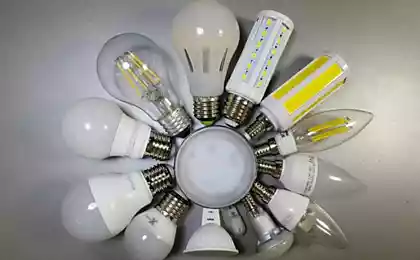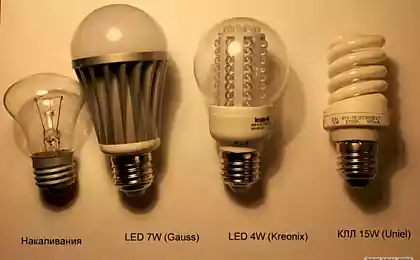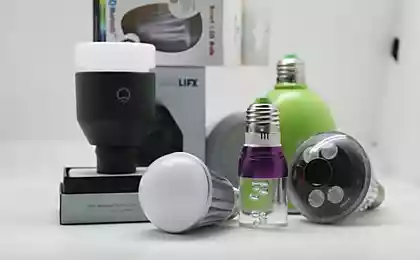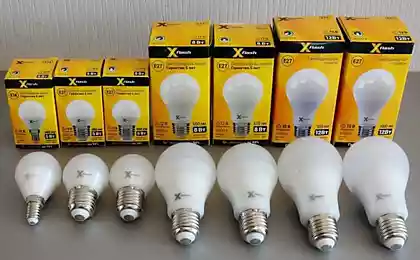694
How to recycle mercury-containing lamps
Surely you know that defective batteries and energy saving light bulbs should be disposed of in dumpsters. The harmful substances contained in them, must be disposed of.
Neglect can lead to the fact that all the rubbish caught up in the landfill, including bulbs, will exude into the air poisonous, dangerous fumes. This is the main reason why recycling of mercury-containing lamps does not tolerate haste.

In addition, mercury together with atmospheric precipitation can get into the river, leaching into the groundwater, causing the substance deposited on the micro-organisms consumed by fish and animals. In turn, the infected animals freely enters the shops, and then on the tables of people who by fate are doomed to poisoning.
Basic information
How does the energy saving light bulb?
Examine the internal structure of a conventional energy saving light bulbs that save electricity consumption used in almost every home.
The base is a spiral, made of glass, with the inside of mercury vapor, on the walls which also features a special coating element called a phosphor.

Mercury vapor, receiving the electrical discharge, emit ultraviolet radiation, which contributes to the subsequent emission of light.
How dangerous is mercury?
Without interaction with other components, pure mercury is not as dangerous as it seems. Empirically determined that if poured onto the surface of a bucket of mercury in contact with air spot will reach about 300 sq. cm it is Noteworthy that mercury vapor does not completely dissolve and is not mixed with air, they are a long "hang" almost motionless.
Penetrating into the body, mercury accumulates as long as a sufficient amount of the substance begins to destroy the Central nervous system and kidneys. The most terrible consequences from the interaction with mercury feel children who can later be identified mental retardation, heart problems. Adults often suffer brain and liver.
Completely abandon mercury-containing product. Despite the fact that the cost of energy-saving light bulbs are somewhat inflated compared to other similar, they are favorably low value of relative electricity consumption and at the same time perfectly illuminate the room.
To protect from mercury vapor and their effects can only correct disposal of energy saving lamps.
How and where to dispose of mercury-containing lamp?
Where to take the faulty device?
Of course, you should ensure that mercury-containing product inadvertently crashed. Then dispose of in a panic and rush anything ahead of schedule is not necessary. To avoid this, you must store lamps in those boxes in which they were purchased originally. If box is lost, it is desirable to wrap the bulb in a thick newspaper sheets and put in a remote place.
After the product has served their term, follow mandatory the recycling process established by the Law of the Russian Federation:
Pack the unit tightly maximum. Please check with your Management company (MC) of the district or the des, which includes the lamp and where exactly is the collection of mercury-containing wastes for subsequent transport to the disposal site. If the UK refuses to help in this matter and do not have the necessary information, contact the district Council at the place of residence. What to do if a lamp breaks?
Of course, complicated situations, no one is safe, so if the lamp is still broken, you need to act quickly and confidently, without succumbing to panic. Remember — it can happen to anyone, the main thing — time to get rid of the dangerous source of mercury vapour and do it right.

To dispose of light bulbs, the product is destroyed and divided into many components, this process is achieved by filtering materials. Get broken glass, black and non-ferrous metals, phosphor etc.
How are the components? Glass is recyclable and is used as a raw material for the manufacture of a variety of glass tools, as an option — as a fill element of a concrete solution. Caps from the lamps are the metal scrap. Of phosphor is again mercury.
Where is the recycling?
Many consumers are interested in the question — where to take away mercury-containing devices for recycling? In Russia operates about 20 factories engaged in processing of wastes, having in its composition of mercury. The largest is "merc". Here we asked whether all of the mercury is suitable for reuse. The Director of the enterprise Dmitry Donskoy noted that the main part of the substance really is reused, and the remaining still be safe for human burial. For this purpose, modern equipment and the latest technology.
SUBSCRIBE to OUR youtube channel that allows you to watch online, download from YouTube free video about the recovery, the rejuvenation of man. Love for others and ourselves, as the feeling of high vibrations — an important factor for improvement .
Put LIKES and share with your FRIENDS!
www.youtube.com/channel/UCXd71u0w04qcwk32c8kY2BA/videos
Foreign experience
To date, the EU is no longer produced thermometers containing mercury. Norway and Sweden have not used toxic substance in the production cycles, it is successfully replaced with alternative safe materials.
Unfortunately, Russia is not yet ready for such radical prohibitions no changes are planned in the near future. Shall not apply and article of the Law, which stipulates that every consumer has the right to receive the necessary information about the purchased product. The realities of life are such that most manufacturers do not provide information about the product in the right amount on the label, by all means conceal aspects of the content of harmful elements.
The section focuses on what made cardboard packaging, but how to dispose of the lamp and where to carry it is not listed anywhere. Of course, there are more bona-fide manufacturers, who at least remind us that energy-saving product should be disposed of in a dumpster.
This begs the next question — what percentage of buyers actually read the labels and icons on the packaging? You might guess that is not too large.
Conclusion
Studying the problem of improper disposal of energy saving lamps, we are faced with indifference and even indifference of consumers in the solution of this problem.
As soon as the population becomes more conscious and think not only about the day immediate, but also future — nobody knows. The main thing — that by this time we have not squandered their own health, otherwise you will have nothing to save. published
Source: repaireasily.ru/volt/utilizaciya-rtutsoderzhashhix-lamp.html
Neglect can lead to the fact that all the rubbish caught up in the landfill, including bulbs, will exude into the air poisonous, dangerous fumes. This is the main reason why recycling of mercury-containing lamps does not tolerate haste.

In addition, mercury together with atmospheric precipitation can get into the river, leaching into the groundwater, causing the substance deposited on the micro-organisms consumed by fish and animals. In turn, the infected animals freely enters the shops, and then on the tables of people who by fate are doomed to poisoning.
Basic information
How does the energy saving light bulb?
Examine the internal structure of a conventional energy saving light bulbs that save electricity consumption used in almost every home.
The base is a spiral, made of glass, with the inside of mercury vapor, on the walls which also features a special coating element called a phosphor.

Mercury vapor, receiving the electrical discharge, emit ultraviolet radiation, which contributes to the subsequent emission of light.
How dangerous is mercury?
Without interaction with other components, pure mercury is not as dangerous as it seems. Empirically determined that if poured onto the surface of a bucket of mercury in contact with air spot will reach about 300 sq. cm it is Noteworthy that mercury vapor does not completely dissolve and is not mixed with air, they are a long "hang" almost motionless.
Penetrating into the body, mercury accumulates as long as a sufficient amount of the substance begins to destroy the Central nervous system and kidneys. The most terrible consequences from the interaction with mercury feel children who can later be identified mental retardation, heart problems. Adults often suffer brain and liver.
Completely abandon mercury-containing product. Despite the fact that the cost of energy-saving light bulbs are somewhat inflated compared to other similar, they are favorably low value of relative electricity consumption and at the same time perfectly illuminate the room.
To protect from mercury vapor and their effects can only correct disposal of energy saving lamps.
How and where to dispose of mercury-containing lamp?
Where to take the faulty device?
Of course, you should ensure that mercury-containing product inadvertently crashed. Then dispose of in a panic and rush anything ahead of schedule is not necessary. To avoid this, you must store lamps in those boxes in which they were purchased originally. If box is lost, it is desirable to wrap the bulb in a thick newspaper sheets and put in a remote place.
After the product has served their term, follow mandatory the recycling process established by the Law of the Russian Federation:
Pack the unit tightly maximum. Please check with your Management company (MC) of the district or the des, which includes the lamp and where exactly is the collection of mercury-containing wastes for subsequent transport to the disposal site. If the UK refuses to help in this matter and do not have the necessary information, contact the district Council at the place of residence. What to do if a lamp breaks?
Of course, complicated situations, no one is safe, so if the lamp is still broken, you need to act quickly and confidently, without succumbing to panic. Remember — it can happen to anyone, the main thing — time to get rid of the dangerous source of mercury vapour and do it right.

- Ensure good ventilation of the room, turn off space heaters and leave the room for a quarter of an hour.
- If you do not have a respirator (which is ideal), wear a tight gauze bandage. Protect your hands with rubber gloves.
- Now gently gather the remnants of shrapnel and pieces of lamps and place them in one tight package or more subtle. Firmly tie the cellophane on multiple nodes. The package can be replaced by a jar with a lid.
- Armed with a table lamp or a powerful flashlight, locate the place where you could get the particles of mercury. If they discovered — put a cardboard sheet or a scraper and collect the substance in the same capacity as the pieces.
- Again carefully walk around the area unnecessary with a damp cloth or napkin and secure the effect of wet cleaning of flooring, don't forget to add in the cleaning solution bleach.
- Pack, cleaning cloth and gloves also gather together and take for disposal (where will tell in the UK). If you have any additional questions — ask for help in emergencies, dial 112.
- Call the sanitation Department and leave a request for field measurement of the concentration of mercury vapor present in the air of the room (it should not be higher than the MPC 0,0003 mg/cubic meter).
To dispose of light bulbs, the product is destroyed and divided into many components, this process is achieved by filtering materials. Get broken glass, black and non-ferrous metals, phosphor etc.
How are the components? Glass is recyclable and is used as a raw material for the manufacture of a variety of glass tools, as an option — as a fill element of a concrete solution. Caps from the lamps are the metal scrap. Of phosphor is again mercury.
Where is the recycling?
Many consumers are interested in the question — where to take away mercury-containing devices for recycling? In Russia operates about 20 factories engaged in processing of wastes, having in its composition of mercury. The largest is "merc". Here we asked whether all of the mercury is suitable for reuse. The Director of the enterprise Dmitry Donskoy noted that the main part of the substance really is reused, and the remaining still be safe for human burial. For this purpose, modern equipment and the latest technology.
SUBSCRIBE to OUR youtube channel that allows you to watch online, download from YouTube free video about the recovery, the rejuvenation of man. Love for others and ourselves, as the feeling of high vibrations — an important factor for improvement .
Put LIKES and share with your FRIENDS!
www.youtube.com/channel/UCXd71u0w04qcwk32c8kY2BA/videos
Foreign experience
To date, the EU is no longer produced thermometers containing mercury. Norway and Sweden have not used toxic substance in the production cycles, it is successfully replaced with alternative safe materials.
Unfortunately, Russia is not yet ready for such radical prohibitions no changes are planned in the near future. Shall not apply and article of the Law, which stipulates that every consumer has the right to receive the necessary information about the purchased product. The realities of life are such that most manufacturers do not provide information about the product in the right amount on the label, by all means conceal aspects of the content of harmful elements.
The section focuses on what made cardboard packaging, but how to dispose of the lamp and where to carry it is not listed anywhere. Of course, there are more bona-fide manufacturers, who at least remind us that energy-saving product should be disposed of in a dumpster.
This begs the next question — what percentage of buyers actually read the labels and icons on the packaging? You might guess that is not too large.
Conclusion
Studying the problem of improper disposal of energy saving lamps, we are faced with indifference and even indifference of consumers in the solution of this problem.
As soon as the population becomes more conscious and think not only about the day immediate, but also future — nobody knows. The main thing — that by this time we have not squandered their own health, otherwise you will have nothing to save. published
Source: repaireasily.ru/volt/utilizaciya-rtutsoderzhashhix-lamp.html






















